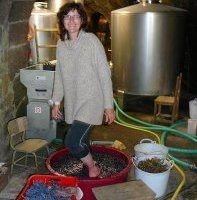Almaroja, Pirita 2007 Arribes

About £18
Find this wine
It’s not that often that I come across a combination of a relatively new appellation and new grape variety, but this lusciously aromatic red from Arribes, a relatively new DO on the Spanish side of the border with Portugal, depends largely on the fragrant Juan García.
It is also made, most unusually and almost single-handedly, by a young 
Almaroja, Pirita 2007 Arribes doesn’t taste as dry or intense as a Douro red, and is much, much more scented and delicate than the bumptious reds made further upstream in Toro. It really does taste like a mountain wine, with a certain minerality and no aggressive tannins, and hides the advertised 14.5% alcohol well. It came as no surprise to learn how naturally it was made.
Average vine age on her 14 hectares of slope is 75 years and the average yield in 2007 was a mere 10 hl/ha. The various varieties are all mixed up in the vineyard so that this is what is known as a field blend of about 70% Juan Garcia, characteristic of the far west of Spain, with much of the rest a mixture of Rufete, Bruñal, Tempranillo and Tinta Madrid, which are picked first as they are early ripeners. The remaining varieties – the exotic-sounding Bastardillo Chico, Bastardillo Serrano, Tinta Jeromo, Gajo Arroba and Verdejo Colorado – tend to ripen at the same time, about two or three weeks later, so are picked together.
These hillside vineyards are at altitudes of between 550 m and 820 m on poor soils made up of sand and various forms of decomposed granite. Charlotte reports that ‘there is a big difference between day- and night-time temperatures (in July and August it generally drops to 12 or 13 ºC at night), which helps to preserve the acidity. Even in 2009 we didn´t need to acidify here. I do most of the vineyard work myself, except in high season when I need help with the debudding. In certain parcels the rows are too narrow, or the land simply too steep to use the tractor, so I had to learn to plough with a mule, which was an experience!
‘Farming is relatively easy here. Apart from erinosis, we don´t have an insect problem. Juan García is susceptible to oidium, but this is easily kept under control with a couple of dustings of sulphur. I use various treatments based on nettles, horsetail, algae and a number of aromatic plants (sage, lavender, rosemary...) depending on the year or problem. I also use the biodynamic treatments 500 and 501 (horn manure and horn silica). I try to follow the biodynamic calendar wherever possible, but with 14 ha to prune on my own this is not feasible, so for instance I try to work on the problematic parcels at the right time to give them a helping hand. I am officially in conversion to organic agriculture, but I´m not really bothered about having biodynamic  status. I do it for personal reasons, not as a sales tool.’
status. I do it for personal reasons, not as a sales tool.’
All the grapes were destemmed. No cultured yeasts were added. About a third was matured in tank and the rest spent 11 months in new and second-use French barriques, followed by six months in tank.
I enjoyed this wine over several evenings and saw little sign of deterioration, and every signs of a strong personality.
The wine is currently imported into the UK by wholesalers Richard Walford, who have so far sold it to Ballantynes Direct of Cowbridge, Amphora Wines of Melton Mowbray, Whistle Wines of Exeter, Define Food & Wine in Northwich, RS Wines of Bristol and Upton on Severn Wines (contact andygoadby@yahoo.co.uk), but I expect to see it more widely distributed.
I can strongly recommend it to those looking for a versatile red that offers a whole range of new flavours and textures. It looks pretty smart too.
Find this wine
Become a member to view this article and thousands more!
- 15,430 featured articles
- 274,111 wine reviews
- Maps from The World Atlas of Wine, 8th edition (RRP £50)
- The Oxford Companion to Wine, 5th edition (RRP £50)
- Members’ forum
- 15,430 featured articles
- 274,111 wine reviews
- Maps from The World Atlas of Wine, 8th edition (RRP £50)
- The Oxford Companion to Wine, 5th edition (RRP £50)
- Members’ forum
- Commercial use of our Tasting Notes
